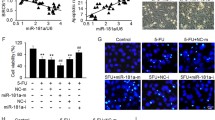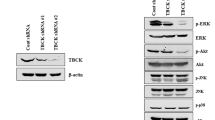Abstract
Renal cell carcinoma (RCC) is the most common types among kidney cancers. Tumor necrosis factor-related apoptosis-inducing ligand (TRAIL) strongly induces apoptosis in RCC. However, TRAIL therapy also leads to hepatotoxicity. To improve the biosafety, we inserted miRNA response elements (MREs) of miR-138, miR-199, and miR-122 into an adenoviral vector, Ad-TRAIL-3MREs, to restrict TRAIL expression within RCC cells. Luciferase assays showed that MREs can regulate the expression of exogenous gene in RCC cells. Ad-TRAIL-3MREs selectively expressed TRAIL and induce apoptosis in RCC cells, but not in normal cells. MTT assays revealed that Ad-TRAIL-3MREs reduced viability of RCC cells without cytotoxicity to normal cells. Ad-TRAIL-3MREs suppressed the growth of ACHN tumors and exerted no hepatotoxicity in vivo. Collectively, we generated a TRAIL-expressing adenoviral vector under the regulation of MREs. This miRNA-based gene therapy may be a promising strategy for RCC treatment.







Similar content being viewed by others
References
Imai E, Isaka Y (2004) Perspectives for gene therapy in renal diseases. Intern Med 43:85–96
Galanis E, Hersh EM, Stopeck AT, Gonzalez R, Burch P, Spier C, Akporiaye ET, Rinehart JJ, Edmonson J, Sobol RE, Forscher C, Sondak VK, Lewis BD, Unger EC, O’Driscoll M, Selk L, Rubin J (1999) Immunotherapy of advanced malignancy by direct gene transfer of an interleukin-2 DNA/DMRIE/DOPE lipid complex: phase I/II experience. J Clin Oncol 17:3313–3323
Wittig B, Marten A, Dorbic T, Weineck S, Min H, Niemitz S, Trojaneck B, Flieger D, Kruopis S, Albers A, Loffel J, Neubauer A, Albers P, Muller S, Sauerbruch T, Bieber T, Huhn D, Schmidt-Wolf IG (2001) Therapeutic vaccination against metastatic carcinoma by expression-modulated and immunomodified autologous tumor cells: a first clinical phase I/II trial. Hum Gene Ther 12:267–278. doi:10.1089/10430340150218404
Kawai K, Tani K, Yamashita N, Tomikawa S, Eriguchi M, Fujime M, Okumura K, Kakizoe T, Clift S, Ando D, Mulligan R, Yamauchi A, Noguchi M, Asano S, Akaza H (2002) Advanced renal cell carcinoma treated with granulocyte-macrophage colony-stimulating factor gene therapy: a clinical course of the first Japanese experience. Int J Urol 9:462–466
Griffith TS, Fialkov JM, Scott DL, Azuhata T, Williams RD, Wall NR, Altieri DC, Sandler AD (2002) Induction and regulation of tumor necrosis factor-related apoptosis-inducing ligand/Apo-2 ligand-mediated apoptosis in renal cell carcinoma. Cancer Res 62:3093–3099
Mahajan S, Dammai V, Hsu T, Kraft AS (2008) Hypoxia-inducible factor-2alpha regulates the expression of TRAIL receptor DR5 in renal cancer cells. Carcinogenesis 29:1734–1741
Dejosez M, Ramp U, Mahotka C, Krieg A, Walczak H, Gabbert HE, Gerharz CD (2000) Sensitivity to TRAIL/APO-2L-mediated apoptosis in human renal cell carcinomas and its enhancement by topotecan. Cell Death Differ 7:1127–1136
He X, Liu J, Yang C, Su C, Zhou C, Zhang Q, Li L, Wu H, Liu X, Wu M, Qian Q (2011) 5/35 fiber-modified conditionally replicative adenovirus armed with p53 shows increased tumor-suppressing capacity to breast cancer cells. Hum Gene Ther 22:283–292
Norian LA, Kresowik TP, Rosevear HM, James BR, Rosean TR, Lightfoot AJ, Kucaba TA, Schwarz C, Weydert CJ, Henry MD, Griffith TS (2012) Eradication of metastatic renal cell carcinoma after adenovirus-encoded TNF-related apoptosis-inducing ligand (TRAIL)/CpG immunotherapy. PLoS ONE 7:e31085
Armeanu S, Lauer UM, Smirnow I, Schenk M, Weiss TS, Gregor M, Bitzer M (2003) Adenoviral gene transfer of tumor necrosis factor-related apoptosis-inducing ligand overcomes an impaired response of hepatoma cells but causes severe apoptosis in primary human hepatocytes. Cancer Res 63:2369–2372
Corazza N, Jakob S, Schaer C, Frese S, Keogh A, Stroka D, Kassahn D, Torgler R, Mueller C, Schneider P, Brunner T (2006) TRAIL receptor-mediated JNK activation and Bim phosphorylation critically regulate Fas-mediated liver damage and lethality. J Clin Invest 116:2493–2499
Al-Ali BM, Ress AL, Gerger A, Pichler M (2012) MicroRNAs in renal cell carcinoma: implications for pathogenesis, diagnosis, prognosis and therapy. Anticancer Res 32:3727–3732
Girgis AH, Iakovlev VV, Beheshti B, Bayani J, Squire JA, Bui A, Mankaruos M, Youssef Y, Khalil B, Khella H, Pasic M, Yousef GM (2012) Multilevel whole-genome analysis reveals candidate biomarkers in clear cell renal cell carcinoma. Cancer Res 72:5273–5284
Tsukigi M, Bilim V, Yuuki K, Ugolkov A, Naito S, Nagaoka A, Kato T, Motoyama T, Tomita Y (2012) Re-expression of miR-199a suppresses renal cancer cell proliferation and survival by targeting GSK-3beta. Cancer Lett 315:189–197
Ma L, Liu J, Shen J, Liu L, Wu J, Li W, Luo J, Chen Q, Qian C (2010) Expression of miR-122 mediated by adenoviral vector induces apoptosis and cell cycle arrest of cancer cells. Cancer Biol Ther 9:554–561
Song T, Zhang X, Wang C, Wu Y, Cai W, Gao J, Hong B (2011) MiR-138 suppresses expression of hypoxia-inducible factor 1alpha (HIF-1alpha) in clear cell renal cell carcinoma 786-O cells. Asian Pac J Cancer Prev 12:1307–1311
Liu J, Ma L, Li C, Zhang Z, Yang G, Zhang W (2013) Tumor-targeting TRAIL expression mediated by miRNA response elements suppressed growth of uveal melanoma cells. Mol Oncol 7(6):1043–1055
Zhao Y, Li Y, Wang L, Yang H, Wang Q, Qi H, Li S, Zhou P, Liang P, Wang Q, Li X (2013) microRNA response elements-regulated TRAIL expression shows specific survival-suppressing activity on bladder cancer. J Exp Clin Cancer Res 32:10
Huo W, Jin N, Fan L, Wang W (2014) MiRNA regulation of TRAIL expression exerts selective cytotoxicity to prostate carcinoma cells. Mol Cell Biochem 388:123–133. doi:10.1007/s11010-013-1904-3
Liang J, Zhang Y, Jiang G, Liu Z, Xiang W, Chen X, Chen Z, Zhao J (2014) miR-138 induces renal carcinoma cell senescence by targeting EZH2 and is downregulated in human clear cell renal cell carcinoma. Oncol Res 21:83–91. doi:10.3727/096504013X13775486749218
Dai BH, Geng L, Wang Y, Sui CJ, Xie F, Shen RX, Shen WF, Yang JM (2013) microRNA-199a-5p protects hepatocytes from bile acid-induced sustained endoplasmic reticulum stress. Cell Death Dis 4:e604. doi:10.1038/cddis.2013.134
Ma L, Liu J, Liu L, Duan G, Wang Q, Xu Y, Xia F, Shan J, Shen J, Yang Z, Bie P, Cui YH, Bian XW, Prieto J, Avila MA, Qian C (2014) Overexpression of the transcription factor MEF2D in hepatocellular cancer sustains malignant character by suppressing G2/M transition genes. Cancer Res. doi:10.1158/0008-5472.CAN-13-2171
Wang B, Liu J, Ma LN, Xiao HL, Wang YZ, Li Y, Wang Z, Fan L, Lan C, Yang M, Hu L, Wei Y, Bian XW, Chen D, Wang J (2013) Chimeric 5/35 adenovirus-mediated Dickkopf-1 overexpression suppressed tumorigenicity of CD44(+) gastric cancer cells via attenuating Wnt signaling. J Gastroenterol 48:798–808
Conflict of interest
None.
Author information
Authors and Affiliations
Corresponding author
Electronic supplementary material
Below is the link to the electronic supplementary material.
11010_2014_2025_MOESM1_ESM.ppt
Supplementary Figure Ad-TRAIL-3MREs depleted endogenous miR-138, miR-199 and miR-122 in normal cells. a The levels of miR-138, miR-199 and miR-122 were examined by qPCR assays in HK-2 and L-02 cells infected with Ad-TRAIL or Ad-TRAIL-3MREs (10 MOI) for 48 h. The bars represented Mean ± SD. b EZH2, GRP78 and MEF2D mRNA were also assessed in normal cell lines 48 h after the treatment of Ad-TRAIL or Ad-TRAIL-3MREs (10 MOI). Mean ± SD were shown. (PPT 133 kb)
Rights and permissions
About this article
Cite this article
Zhang, Z., Zhang, H., Li, H. et al. Selective expression of tumor necrosis factor-related apoptosis-inducing ligand mediated by microRNA suppresses renal carcinoma growth. Mol Cell Biochem 392, 125–134 (2014). https://doi.org/10.1007/s11010-014-2025-3
Received:
Accepted:
Published:
Issue Date:
DOI: https://doi.org/10.1007/s11010-014-2025-3




